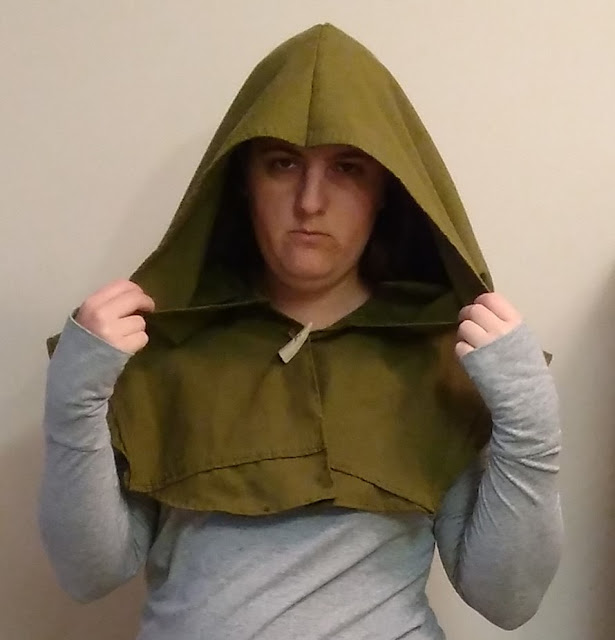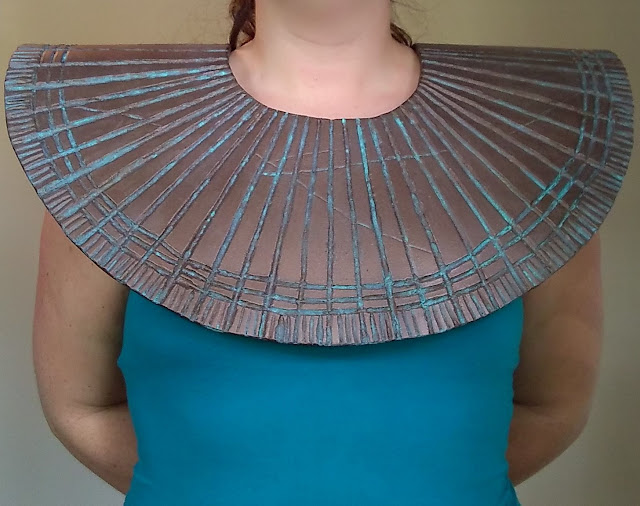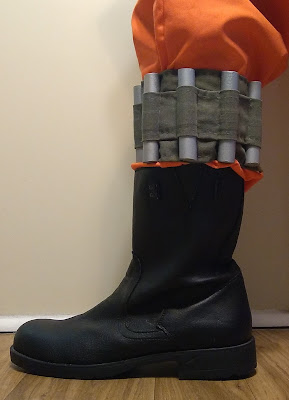How to make bracers out an old leather purse
First let’s get one thing straight. Although bracers and vambraces are worn on the forearm, they are not the same. A vambrace is a piece of leather or metal armor meant to protect the outside of the forearm and deflecting hacking blows. Sometime they encase both the outer and inner arm, and sometimes just the outer arm. They are generally part of a medium- to heavily-armored melee fighter on foot or horseback. A bracer is worn to protect the inside of the arm from the slap of a bowstring, and to keep long sleeves from interfering with the draw of the bow. An archer may only wear one to protect the arm holding the bowstave, or wear two to secure the sleeves. Bracers can be made of leather or cloth, and have no real value as melee armor. Which is fine, because archers don’t intend to let an enemy to get close enough for that to matter. Since the character I’m building relies on stealth, agility, and long-ranged weaponry, I opted to make bracers rather than vambraces. But certainly you could adapt this tutorial to making a pair of vambraces, though I’d recommend making it thicker and adding metal plate elements to make them more believable.
Materials
-Leather purse
-Rivets
-Snaps
Tools
-Needle/thread
-Scissors
-Superglue
1. Gather the materials
I originally tried making the bracers out of “leather” vinyl, but found that it just doesn’t have the same feel or look to it. The vinyl is too thin so it crinkles up, and the material has too much shine to it. For a piece like this, where the give and thickness So I set out to get some leather to work with. You can buy it in the craft store, or in bulk online, but it will cost you an arm and a leg. At any thrift store you can get nice well-worked leather pieces for significantly less, you just have to check in the purses. It takes a little effort to determine if it’s leather, its quality, and to find the color and texture you’re looking for. I bought this purse from a thrift store for $6. The handles were a bit worn and would break under extended use, but the leather of the sides were clean and in good condition. Certainly good enough for me to take it apart. The structure of this particular purse drew me, since the center panel is pretty much the size of the bracer I was planning anyway. But as long as you found a purse with enough material it should work as well.
2. Cut the leather
It was fairly easy for me to cut the right size bracer, as the panels of the purse provided the right size and shape. The dimensions are going to be different for everyone, but I used a forearm length of 8.75 inches, the wrist width is 5.25 inches, and the upper forearm width is 8.25 inches.
3. Cut and modify the straps
To make the straps to secure the bracer to the arm, I decided to cut up and modify the purse straps. The ends of the straps have rivets, so when I was making other straps I mimicked these ends, curving them and add the single rivet. For the strap lengths, I experimented with the proper lengths for my arm, but ultimately I trimmed the straps to two shorter straps at 4.5 inches and one longer strap at 5.5 inches.
4. Attach the straps
Next, use needle and dark all-purpose threat to attach the straps to the bracer. I did this by hand using a basic running stitch, though to get through the leather I needed pliers to pull the needle through. Too thick really to risk on a sewing machine.
I chose to set three straps at even intervals, though I also toyed with adding a fourth.
6. Finish
Once you attach the snaps cut off the excess strap. Use the same measurements for the straps and mirror that strap placement if you're making a second bracer. Good luck and keep crafting!
Materials
-Leather purse
-Rivets
-Snaps
Tools
-Needle/thread
-Scissors
-Superglue
1. Gather the materials
I originally tried making the bracers out of “leather” vinyl, but found that it just doesn’t have the same feel or look to it. The vinyl is too thin so it crinkles up, and the material has too much shine to it. For a piece like this, where the give and thickness So I set out to get some leather to work with. You can buy it in the craft store, or in bulk online, but it will cost you an arm and a leg. At any thrift store you can get nice well-worked leather pieces for significantly less, you just have to check in the purses. It takes a little effort to determine if it’s leather, its quality, and to find the color and texture you’re looking for. I bought this purse from a thrift store for $6. The handles were a bit worn and would break under extended use, but the leather of the sides were clean and in good condition. Certainly good enough for me to take it apart. The structure of this particular purse drew me, since the center panel is pretty much the size of the bracer I was planning anyway. But as long as you found a purse with enough material it should work as well.
2. Cut the leather
It was fairly easy for me to cut the right size bracer, as the panels of the purse provided the right size and shape. The dimensions are going to be different for everyone, but I used a forearm length of 8.75 inches, the wrist width is 5.25 inches, and the upper forearm width is 8.25 inches.
3. Cut and modify the straps
To make the straps to secure the bracer to the arm, I decided to cut up and modify the purse straps. The ends of the straps have rivets, so when I was making other straps I mimicked these ends, curving them and add the single rivet. For the strap lengths, I experimented with the proper lengths for my arm, but ultimately I trimmed the straps to two shorter straps at 4.5 inches and one longer strap at 5.5 inches.
4. Attach the straps
Next, use needle and dark all-purpose threat to attach the straps to the bracer. I did this by hand using a basic running stitch, though to get through the leather I needed pliers to pull the needle through. Too thick really to risk on a sewing machine.
I chose to set three straps at even intervals, though I also toyed with adding a fourth.
5. Add snaps
All right, so snaps are a bit of an anachronism. But I thought this would be an easy way to utilize the straps, and I must master the art of snap-setting. This could be a terrible mistake, but only one way to find out. In this picture you can see6. Finish
Once you attach the snaps cut off the excess strap. Use the same measurements for the straps and mirror that strap placement if you're making a second bracer. Good luck and keep crafting!














We are an online travel products store - Our best sellers include genuine leather purses and briefcases imported from Italy - we also carry travel bags, handbags, wallets, leather pouches, carry cases, briefcases, leather pouches, travel adapters, awesome quality Thai shirts, and more at https://www.rickshawjourney.com/
ReplyDelete